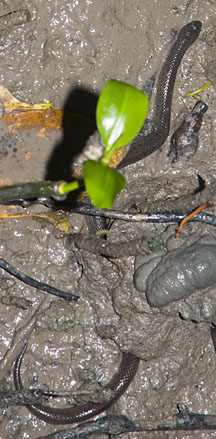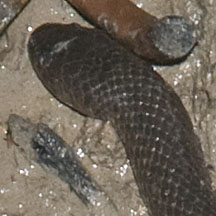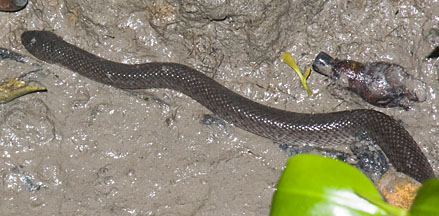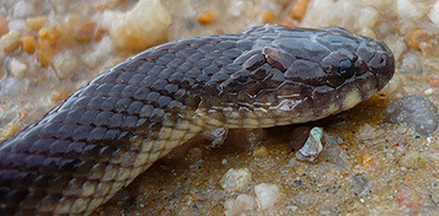 |
|
| snakes text index | photo index |
| Phylum Chordata > Subphylum Vertebrata > Class Reptilia > shore snakes |
| Crab-eating
water snake Fordonia leucobalia Family Homalopsidae updated Oct 2016 Where seen? Rarely seen, usually in mangroves such as Pasir Ris and Sungei Buloh, often near mud lobster mounds. This snake is nocturnal and is seldom seen during the day. Features: To about 90cm long. The head is rounded and not distinct from the body, i.e., it has no 'neck', Cylindrical body with smooth scales and a relatively short tail. Colour purplish brown above fading to white underneath. Mildly venomous, it is a gentle snake and will not bite if it is left alone. What does it eat? It eats mainly hard-shelled crabs, hunting for and capturing them in the crab burrows. It also eats small fishes. Baby snakes: Mama snake gives birth to live young in litters of 6-15. Status and threats: The snake is listed as 'Endangered' on the Red List of threatened animals of Singapore. |
 Pasir Ris Park, Mar 12 |
 Pasir Ris Park, Mar 12 |
 Pasir Ris Park, Mar 12 |
|
| Crab-eating water snakes on Singapore shores |
| Photos of Crab-eating water snakes for free download from wildsingapore flickr |
| Distribution in Singapore on this wildsingapore flickr map |
Crab eating snake & Dinner @ Pasir Ris Mangrove - June 2014 from SgBeachBum on Vimeo. |
| Dr. Bruce Jayne of the University of Cincinnati (Ohio, USA) shot this infra-red video of a captive snake (Fordonia leucobalia) eating a crab (Episesarma versicolor) that was very near the upper size limit of what it could sallow. From start to finish this epic battle took nearly a half an hour! The snake had a body (SVL) length of 59 cm and was 152 grams and the crab was 15.2 grams. This individual was captured and observed in Singapore at the National University of Singapore. This species of snake occurs on the intertidal mud flats and muddy surfaces of the mangroves along the coasts of many Southeast Asian countries where crabs are an abundant resource. This snake uses a unique behavior of pinning the crab with its chin, neck and body before it bites the crab, whereas other snakes capture prey using an open-mouth strike, during which the needle sharp teeth snag soft-bodied prey. |
Links
|
|
|
